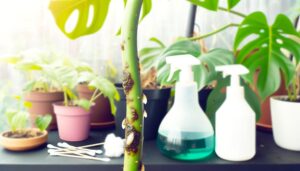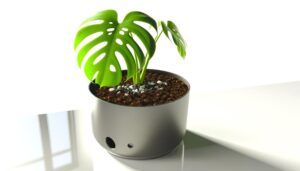Best Pot for Monstera Deliciosa: Choosing Perfect Container!
The best pot for Monstera deliciosa should provide sufficient root space and efficient drainage to prevent root rot. Ideal materials include terracotta for improved aeration and plastic for moisture retention, each requiring careful watering.
Self-watering pots are beneficial, maintaining consistent hydration and reducing watering frequency. Stability is essential; heavier pots like terracotta or ceramic prevent tipping, while wide bases offer additional support.
Brands such as Lechuza and Fox & Fern excel with features like built-in reservoirs and durable construction, promoting strong growth. For detailed insights into pot selection, each aspect warrants closer examination.
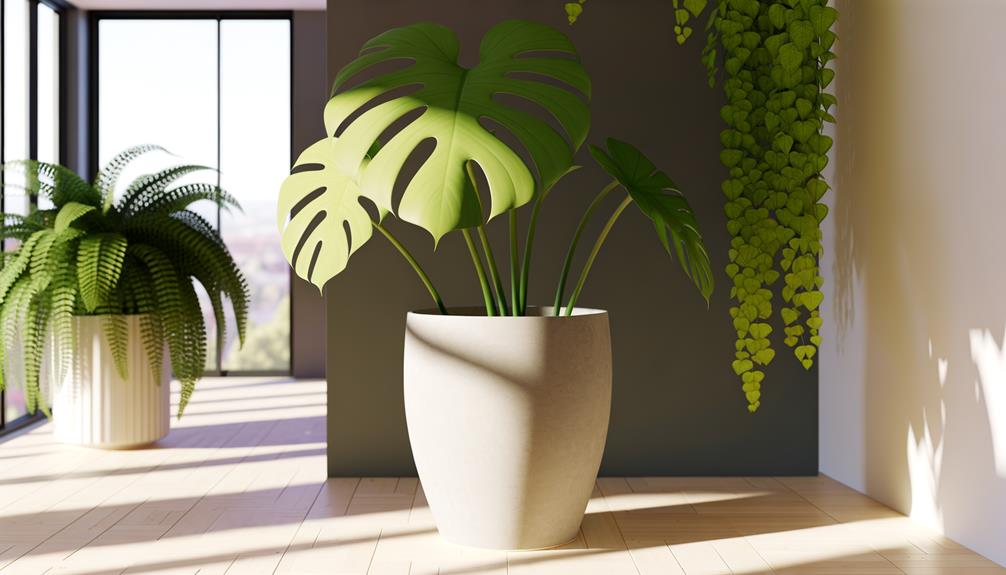
Key Takeaways
- Choose a pot with drainage holes to prevent root rot and maintain optimal soil aeration.
- Opt for terracotta or ceramic pots for stability and support, accommodating Monstera’s robust growth.
- Ensure the pot is large enough to provide adequate space for root expansion and aerial root support.
- Consider self-watering pots like Lechuza for regulated hydration and reduced watering frequency.
- Select aesthetically pleasing pots that complement Monstera’s foliage, enhancing its visual presence.
Understanding Monstera Deliciosa Needs
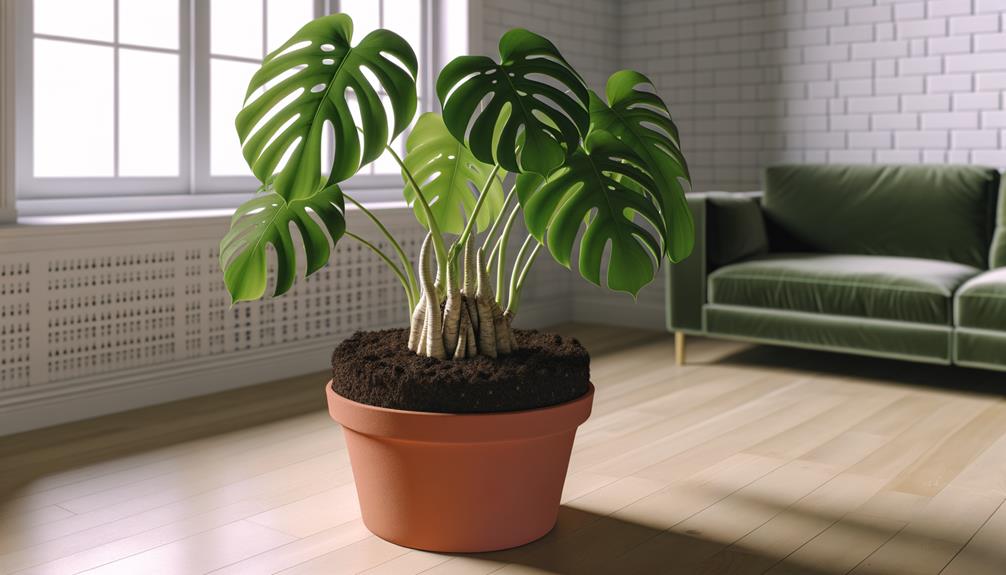
To properly care for Monstera deliciosa, it is important to understand its specific physiological and environmental requirements.
Monstera deliciosa, a member of the Araceae family, thrives in indirect light, replicating its native understory tropical habitat. Best growth occurs in temperatures between 18-27°C, with humidity levels of 60-80%.
The plant’s aerial roots necessitate support structures, such as moss poles, to emulate natural climbing conditions. Soil composition should be well-draining, rich in organic matter, with a pH ranging from 5.5 to 7.0.
Regular watering is essential, but caution against waterlogged conditions which can induce root rot. Fertilization during the growing season with a balanced, water-soluble fertilizer promotes robust growth and foliar development, ensuring the plant’s health and well-being.
Importance of Pot Size
Selecting the suitable pot size for Monstera Deliciosa is crucial to ensuring best plant health and growth. Adequate root growth space is essential for nutrient uptake and overall plant vigor, while proper drainage and aeration mitigate root rot risks and promote oxygen exchange.
In addition, a correctly sized pot provides necessary stability and support to accommodate the plant’s substantial aerial roots and expansive foliage.
Root Growth Space
Adequate root room is crucial for the best development and health of Monstera deliciosa, as it directly impacts nutrient absorption, water retention, and overall plant stability. Insufficient root space can constrain the plant’s ability to access water and essential nutrients, leading to stunted growth and compromised physiological functions.
Ideal root expansion facilitates efficient metabolic processes, enhancing the uptake of macronutrients such as nitrogen, phosphorus, and potassium. Additionally, sufficient space prevents root-bound conditions, where roots entangle and restrict vascular functions.
A pot that allows for unobstructed root growth guarantees structural stability, reducing the likelihood of tipping and providing a strong foundation. Choosing an appropriately sized pot is crucial for fostering vigorous, healthy growth in Monstera deliciosa.
Drainage and Aeration
Proper drainage and aeration are fundamental aspects affected by pot size, directly influencing the health and growth dynamics of Monstera deliciosa. Adequate drainage ensures excess water escapes, preventing root rot caused by waterlogged conditions.
Conversely, insufficient aeration impedes oxygen exchange, vital for root respiration and nutrient uptake. Pot size directly impacts these parameters; overly large pots retain excess moisture, exacerbating fungal infections, while undersized pots restrict root expansion and air circulation.
Optimal pot sizing harmonizes moisture levels with air flow, fostering a balanced microenvironment. Utilizing pots with drainage holes and well-aerated soil mixes, such as perlite or orchid bark, further enhances these conditions, promoting robust root development and overall plant well-being.
Stability and Support
The size of the pot plays a significant role in providing stability and support for Monstera deliciosa. An appropriately sized pot guarantees the plant remains upright and reduces the risk of tipping over.
An ideal pot size ensures the root system has sufficient space to expand, thereby anchoring the plant securely. This stability is vital as Monstera deliciosa grows larger and heavier.
- Root Expansion: Adequate space allows roots to grow, enhancing anchorage.
- Weight Distribution: A larger pot distributes the weight more evenly, preventing top-heaviness.
- Structural Integrity: Proper pot size maintains the structural integrity of the plant.
- Nutrient Absorption: Sufficient root space ensures efficient nutrient and water uptake.
Selecting the right pot size is crucial to maintaining a healthy, stable Monstera deliciosa.
Drainage Considerations
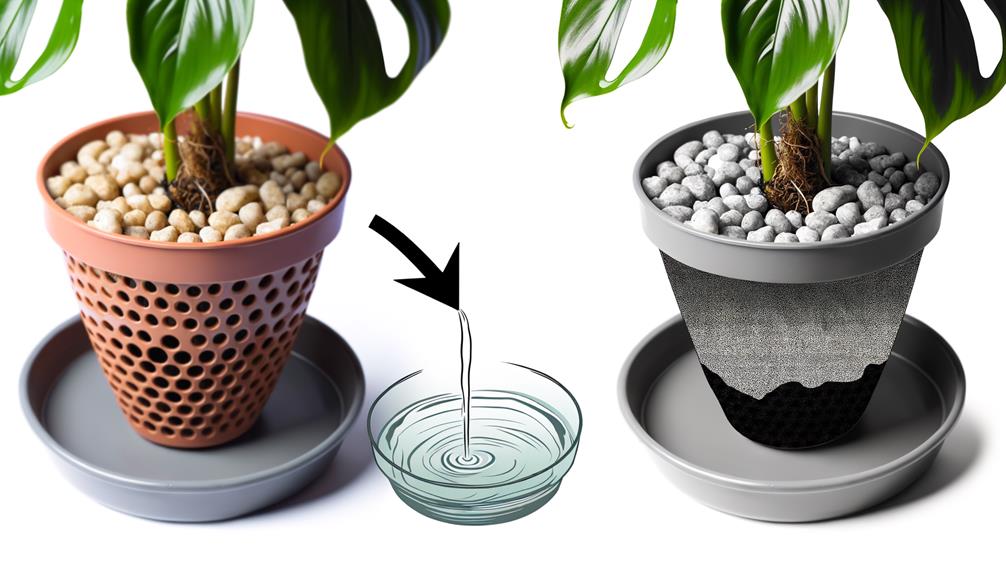
Effective drainage is vital for the health of Monstera Deliciosa, as it prevents root rot by facilitating the removal of excess water.
The presence of adequate drainage holes in the pot guarantees that the soil remains well-aerated and does not become waterlogged.
Consequently, selecting a pot with proper drainage mechanisms is essential to maintaining ideal soil moisture levels and promoting robust plant growth.
Importance of Drainage Holes
Securing sufficient drainage in the pot for Monstera deliciosa is crucial to prevent root rot and promote healthy plant growth. Drainage holes aid in the removal of excess water, thereby maintaining ideal moisture levels in the soil. This function is essential for Monstera deliciosa, as it thrives in well-aerated, moderately moist environments.
Effective drainage can be achieved through:
- Prevention of Water Accumulation: Excess water can lead to oxygen-deprived conditions, harmful to root health.
- Improved Oxygen Availability: Proper drainage guarantees roots receive sufficient oxygen, necessary for cellular respiration.
- Control of Pathogenic Growth: Stagnant water can harbor harmful pathogens, which can infect the plant.
- Regulation of Soil Moisture: Ensures that soil does not retain excessive moisture, promoting a balanced microenvironment.
Understanding these aspects is crucial for ensuring the strong growth of Monstera deliciosa.
Avoiding Waterlogged Soil
Why is it important to avoid waterlogged soil for Monstera deliciosa cultivation?
Monstera deliciosa, a tropical epiphyte, has evolved to thrive in well-drained environments. Excess moisture in the root zone can lead to hypoxic conditions, inhibiting root respiration and fostering pathogenic fungal growth, such as Pythium and Phytophthora species. These pathogens cause root rot, compromising nutrient uptake and overall plant health.
Best drainage is achieved through selecting pots with adequate drainage holes and utilizing a well-aerated substrate, such as a mix of peat, perlite, and orchid bark. Ensuring proper drainage mitigates anoxic stress and supports healthy root development, essential for the robust growth and longevity of Monstera deliciosa.
Therefore, drainage considerations are crucial for maintaining plant vitality.
Material Choices
Selecting the appropriate material for a Monstera deliciosa pot is crucial for ensuring best root health, proper drainage, and overall plant strength. The material greatly influences the plant’s environment by impacting moisture retention, aeration, and thermal regulation.
Consider the following options:
- Terracotta: Porous, improving air circulation and preventing root rot by allowing excess moisture to evaporate.
- Plastic: Lightweight and impermeable, retains moisture longer but may require more attentive watering practices to avoid waterlogging.
- Ceramic: Glazed ceramics offer aesthetic appeal while retaining moisture, but lack permeability, requiring adequate drainage holes.
- Fabric Grow Bags: Encourage excellent aeration and drainage, reducing the risk of overwatering and root-bound conditions.
Each material presents unique benefits and potential drawbacks, crucial for ideal Monstera care.
Aesthetic Appeal
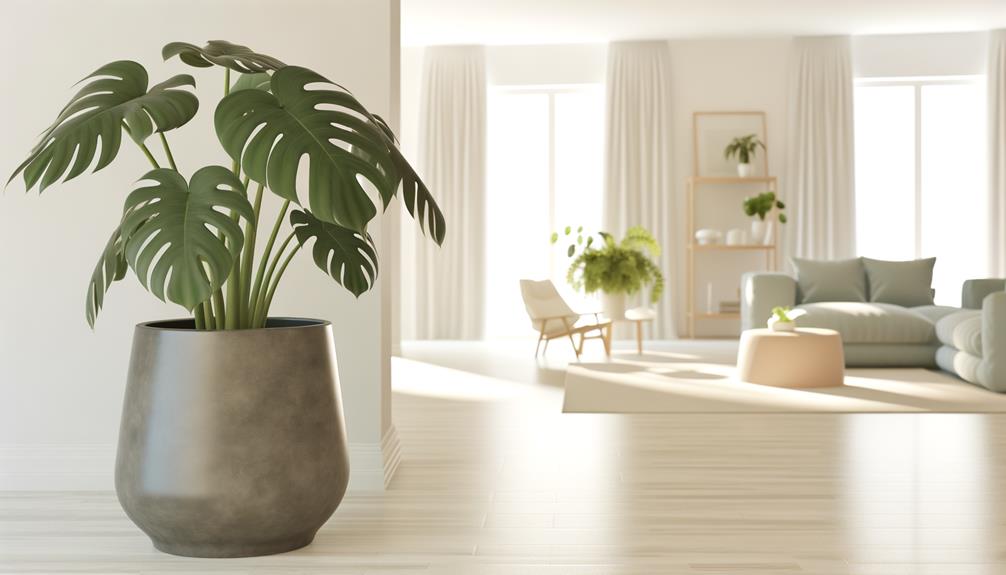
While the material choice greatly impacts the health and growth of Monstera deliciosa, the aesthetic appeal of the pot also plays an essential role in complementing the plant’s visual presence and enhancing the overall ambiance of the space.
A pot’s design, color, and texture should harmonize with the Monstera’s lush green foliage and unique fenestrations, accentuating its natural beauty.
Contemporary minimalist styles with clean lines can provide a sleek backdrop, while rustic or handcrafted pots can lend an organic, earthy feel. Glazed ceramics, matte finishes, and natural stone options offer various aesthetic dimensions.
The pot should serve as a visual anchor, integrating seamlessly into the interior decor while ensuring the plant remains the focal point of the display.
Stability and Support
Providing the pot with sufficient stability and support is crucial for the structural strength and healthy development of Monstera deliciosa. This tropical plant demonstrates robust growth and can become quite heavy at the top, requiring a pot that securely anchors it.
Key factors to take into account include:
- Material: Heavier materials like terracotta or ceramic offer better stability compared to lightweight plastic.
- Size: A pot with a wider base reduces the risk of tipping over as the plant grows.
- Weight Distribution: Make sure the pot’s weight is evenly spread to avoid imbalance.
- Support Structures: Including stakes or moss poles within the pot can provide extra support for climbing or spreading stems.
Choosing a pot that meets these criteria guarantees the best support and stability for Monstera deliciosa.
Self-Watering Pots

In addition to stability and support, enhancing water delivery through self-watering pots can greatly improve the growth and health of Monstera deliciosa.
Self-watering systems utilize capillary action to deliver water directly to the plant roots, ensuring consistent moisture levels. This method mitigates the risk of overwatering and root rot, which are common issues in traditional pots.
| Feature | Benefit | Scientific Insight |
|---|---|---|
| Consistent Moisture | Prevents water stress | Promotes steady transpiration rates |
| Root Aeration | Enhances oxygen availability | Supports root respiration |
| Water Reservoir | Reduces watering frequency | Maintains ideal hydration balance |
| Wick System | Uniform water distribution | Improves nutrient uptake efficiency |
Adopting self-watering pots can thereby provide a controlled environment, fostering robust Monstera growth.
Repotting Frequency
Determining the best repotting frequency for Monstera deliciosa is important for ensuring its continued growth and overall health. Monstera deliciosa, a tropical epiphyte, typically requires repotting every 1-2 years. This interval supports root expansion and nutrient absorption, preventing root-bound conditions that can stunt growth.
Key indicators for repotting include:
- Root Visibility: Roots emerging from drainage holes signal the need for a larger pot.
- Soil Compaction: Diminished soil aeration necessitates new, well-draining substrate.
- Stunted Growth: A halt in foliage expansion suggests insufficient root space.
- Nutrient Depletion: Discolored leaves indicate nutrient-poor soil requiring renewal.
Recommended Pot Brands
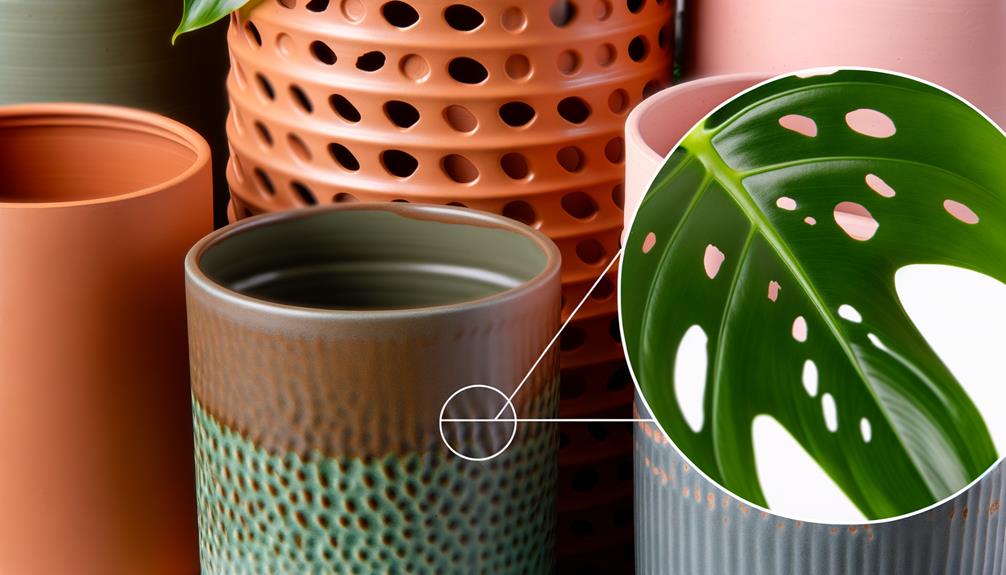
Choosing high-quality pot brands is pivotal in maintaining the health and growth of Monstera deliciosa, especially after repotting. Superior pot brands that excel in drainage, material durability, and aesthetic appeal are essential for optimizing root aeration and preventing waterlogging.
Below is a table summarizing top-recommended pot brands for Monstera deliciosa:
| Brand Name | Material Type | Key Features |
|---|---|---|
| Lechuza | Self-Watering Plastic | Built-in water reservoir |
| Fox & Fern | Fiberstone | Lightweight, durable |
| HBServices USA | Polypropylene | Excellent drainage, eco-friendly |
These brands are renowned for their scientific design that promotes root health through efficient water management and robust materials. Choosing from these options guarantees a conducive environment for Monstera deliciosa, facilitating its lush growth and physiological resilience.
Conclusion
Selecting the best pot for Monstera deliciosa is an endeavor of paramount importance, demanding an astute understanding of the plant’s specific needs. The pot must provide excellent drainage, accurate size dimensions, and material durability.
These factors, combined with aesthetic considerations and the potential benefits of self-watering pots, underscore the complexity of this seemingly simple task. Neglecting such critical aspects could result in catastrophic consequences for the plant’s health and stability, making informed choices indispensable.

